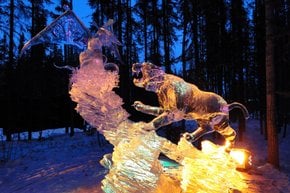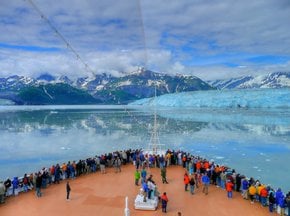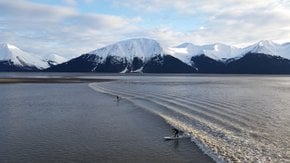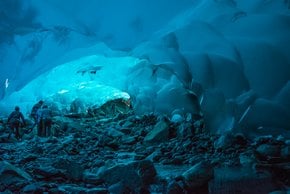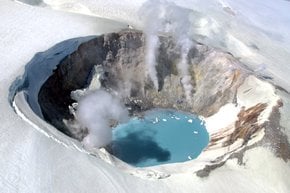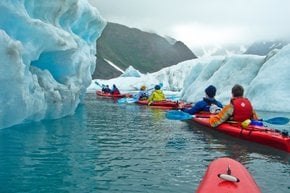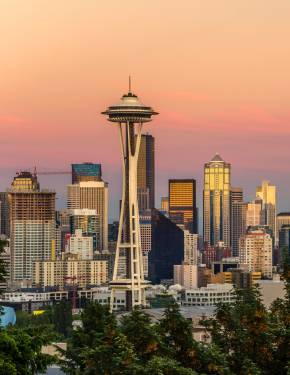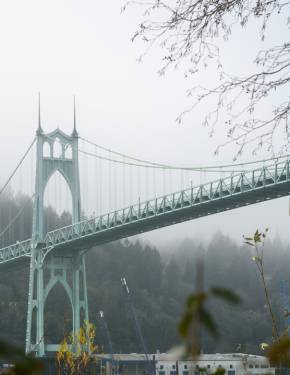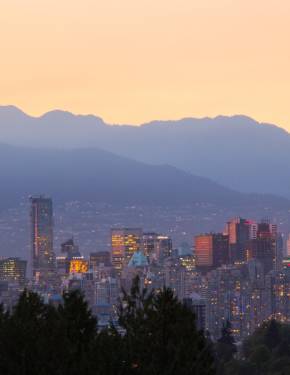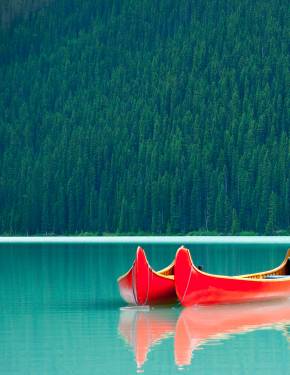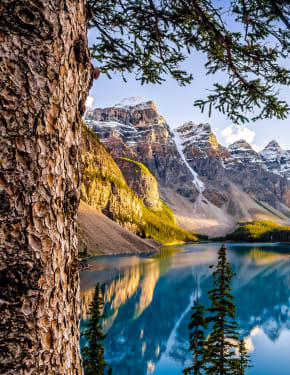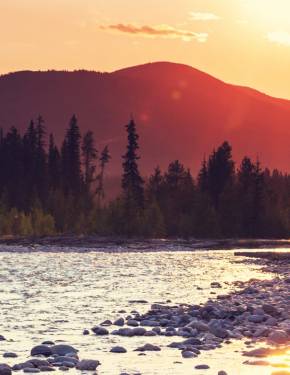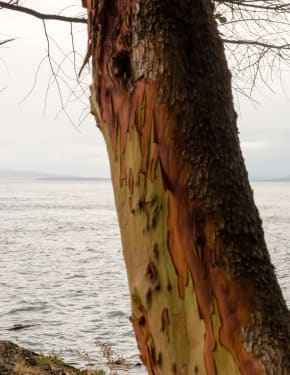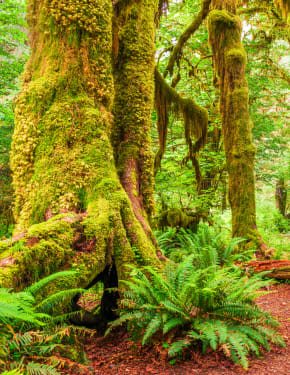Whale Watching in Alaska 2026
Whales are the largest mammals in the world. Seeing them is a truly unforgettable experience!
Best time: April–August
Alaska’s pristine, icy waters provide an ideal habitat for the world’s largest mammals. Whale watching here is exceptional, with opportunities to see various whale species during the warmer months. Humpback, gray, minke, and orca whales all inhabit the state’s waters. In fact, over a dozen whale species can be observed in Alaska’s diverse coastal and marine ecosystems.
When Can You See Whales in Alaska?
The best time to see these majestic marine mammals is from June until August. However, there's an even more fascinating period to observe them. From April to May, you can witness the great gray whale migration through Alaskan waters as they journey north to the Arctic Ocean in search of food. This annual migration is a spectacular sight. Each spring, thousands of humpback and gray whales travel from the warm waters of Hawaii and Mexico to feed in Alaska's nutrient-rich waters, making Alaska one of the top spots for summer whale watching. Additionally, orca whales inhabit Alaska's waters year-round, adding to the experience.
Best Places for Whale Watching
There are plenty of organized tours from Ketchikan, Sitka, Kodiak, or Seward, depending on where you are planning to visit and when these areas of Alaska will provide you with great opportunities to spot a whale. Pack your binoculars, strap on your sea legs, and find your ticket to ride in the waters surrounding the United States' westernmost land mass.
Whale-Watching Tours
The water around the southern coast of Alaska, stretching from the Aleutian Islands chain east to the Hecate Strait, is known as the Gulf of Alaska and is the northern endpoint for the migration of several whale species. These waters are cold, rich, and teeming with life. Before humanity called this part of the world home millennia ago, migrating whales used these waters to feed.
Ketchikan
If you're bound for Ketchikan, you will have no trouble finding one of the many whale-watching cruise companies. We recommend Ketchikan Outdoors. Unlike many of the larger whale-watching companies, this family-friendly boat tour accommodates up to six people per tour. It is perfect for families looking for an inexpensive view of the coast! The Harborview tour typically lasts around 1 hour and costs $75 per adult. Expect to see humpback and orca whales, as well as the myriad of accompanying wildlife such as salmon, seals, balk eagles, and maybe even a porpoise.
Sitka
Sitka Tours offers 2 to 3-hour boat tours through rainforest, ocean marine, and kelp forest habitats for a price of $135 per passenger. Children under two ride for free! The company specializes in humpback whale sightings, but be prepared to see harbor seals, Stellar sea lions, sea otters, brown bears, and the majestic bald eagle.
Kodiak
To Alaskan standards, Kodiak Island is one of the premier sites for whale watching. Many charter boats that offer whale-watching tours can be found throughout the harbors here, so call ahead and find the best one. For an educational side-quest, check out the wealth of information on display at the Kodiak Wildlife Refuge Visitor's Center. Here, you will find the skeleton of a 37-foot gray whale that was found on a nearby beach in 2000. Being able to take in this sight, as well as the other displays throughout their exhibit hall, will bring a valuable perspective to your whale and wildlife expedition in the area.
Seward
For whale watching in Seward, consider exploring small-group tours with various options. These tours typically accommodate up to six people and offer excursions ranging from 3 to 9 hours. Prices generally range from $145 to $375 per passenger. The peak season for whale-watching tours is from mid-May to the end of July.
Whale-Watching Season
Many of the cetaceans found in the Gulf of Alaska are migratory. They move from their southern calving grounds in shallow, warm, and safe waters closer to the equator (such as the Sea of Cortez in Mexico's Baja peninsula or Hawaii to the rich, deep waters of the Bering Sea and Gulf of Alaska where North America and Asia meet. In the case of the gray whale, they swim down to the warm, shallow, and safe waters of the Sea of Cortez. Humpback whales are known to calve in a few select lagoons around Maui, Lanai, and Molokai. Summer is the best time to view whales in Alaska. Although the possibility of catching a glimpse of these marine giants exists in spring and fall, we don't recommend it, as the climate quickly turns frosty without the sun to warm things up.
Orca Whale
(Orcinus orca), known simply as an orca whale, are frequent visitors of the area when salmon are performing their summer run. They use the rich waters here for feeding. These whales travel in family groups or pods of 4 to 7 and are sure to take your breath away.
Gray Whale
Gray whales (Eschrichtius robustus) travel some of the longest migration routes of any mammal! Covering well over 10,000 mi (16,093 km) every year, they head from Alaska to Mexico and back again. Such an incredible feat requires lots of energy and food that whales find in the bountiful waters around Alaska's southern coast. Grey whales are a type of baleen, which means they filter food through bristly growths in their mouth. These whales grow up to 49 feet (15 m) long and can weigh upwards of 40 tons!
Humpback Whale
One of the most well-known and widespread whales is the humpback (Megaptera novaeangliae). Known as one of the largest mammals on earth, it was once hunted to extinction. Through legal protections and conservation efforts, this species has come back from near-extinction to continue to be viewed and appreciated from a distance. Humpbacks are known for their melodious calls that can be heard for miles.
Minke Whale
Minke (pronounced 'mink-ee') whales (Balaenoptera acutorostrata), also known as little piked whales, can grow to more than 30 feet (9 m) in length and weigh over seven tons. These black and white whales have long dorsal fins and ridges around their backs near their tails. Because of their feeding habits and shy nature, these animals aren't frequently seen nor is much known about their migration habits. Try your luck on a cruise, and maybe you'll learn a thing or two about the smallest baleen whale in North American waters.
Whale-Watching Tips
Since whales are always on the move, their exact location is difficult to predict, and their behavior isn't influenced much by the time of day, weather, wind, or tide. Spending two to three hours at sea significantly increases your chances of spotting them, as they regularly come to the surface. Be patient and keep your camera ready. A pair of binoculars can be very useful during your excursion, and a waterproof bag or case is essential for protecting your phone and camera. Expect cooler temperatures and stronger winds on the water compared to land. Additionally, water can reflect UV light, raising the risk of sunburn. If you're prone to motion sickness, bring over-the-counter medication to help manage it.
What to Wear
Dress in layers if possible. It's easy to take off clothing if you get too hot. Consider wearing long pants, a hat, closed-toed shoes, and possibly sunscreen to reduce your exposure to UV rays. A waterproof jacket is always a good idea. Some of the tours available to you will have sheltered locations on the boat that you can use in case of rain, but being prepared for anything will help you have a great time on the water.
What to Bring
Having some snacks and a beverage with you on tour is never a bad idea. Finally, to get a better view of the wildlife you may encounter, bring binoculars or a telescoping camera. Having these on hand could help you identify each whale species you encounter.
Photography Tips
Capturing a picture of a whale requires patience, observation, and quick reflexes. Start by studying the whale's behavior. For example, when feeding, whales often create a frenzy among diving birds—if you spot this, be prepared for a potential lunge or trap feeding moment. Position your focus on the area where the birds are most active, as the whale may surface suddenly. For action shots, like breaching or tail fluke displays, watch for key signals. A whale arching its back higher than usual often indicates it's about to dive deep, providing a prime opportunity for a tail shot. Breaching can be more unpredictable, but if a whale breaches once, it might do so again, so stay ready. Lens choice is also important. A wide-angle lens is great for capturing the whale in its vast ocean environment, offering context and scale. For closer action, a lens with a shorter focal length is easier to manage, as it provides a wider field of view, making it easier to track and focus on the whale.





























































